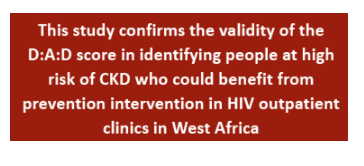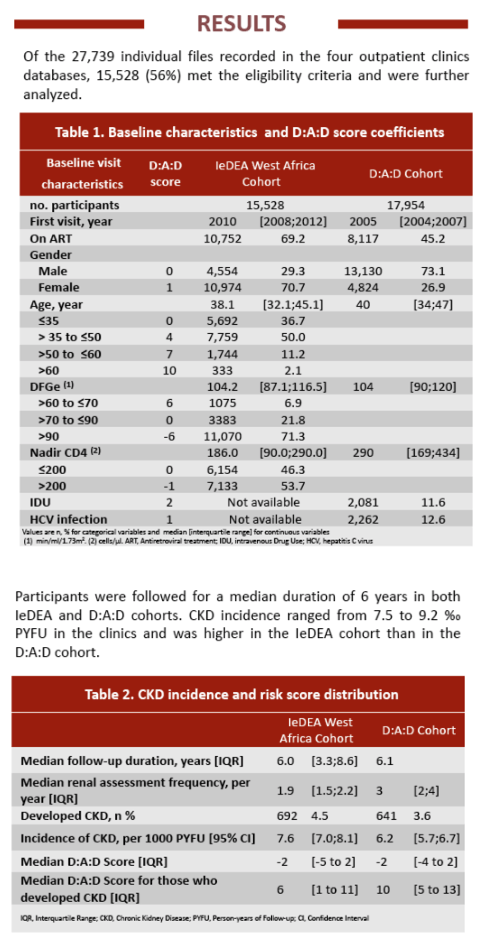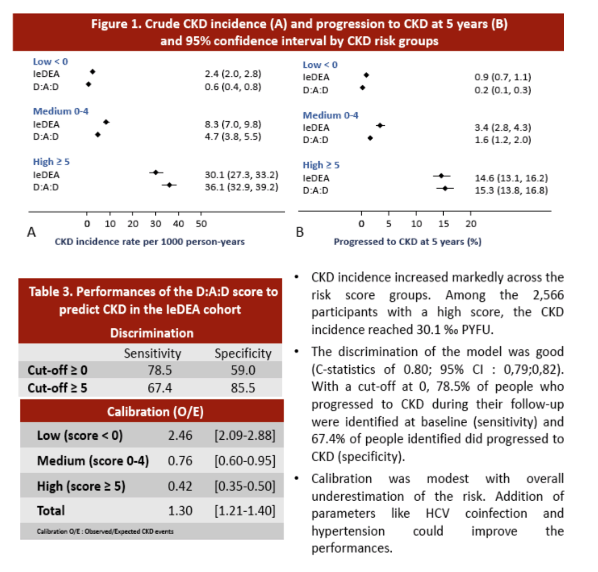 |
 |
 |
| |
Kidney Disease Rates in DAD & West Africa at Young Ages: VALIDATION OF THE D:A:D CHRONIC KIDNEY DISEASE (CKD) RISK SCORE IN A LARGE AFRICAN COHORT
|
| |
| |
Download the PDF here

Development and Validation of a Risk Score for Chronic Kidney Disease in HIV Infection Using Prospective Cohort Data from the D:A:D Study
.....https://journals.plos.org/plosmedicine/article?id=10.1371/journal.pmed.1001809
Age, HIV exposure route, hepatitis C coinfection, gender, nadir CD4 count, hypertension, CVD, and diabetes, have all been previously shown to be associated with CKD, so their inclusion in our score was expected. The factors included in our risk score model, and the number of points these factors contributed to the risk score, highlight the need for patient monitoring, screening, and chronic disease prevention to minimise the risks of developing diabetes, hypertension, or CVD, as well as the risk of becoming hepatitis C virus coinfected.
HIV exposure group (intravenous drug user versus all others), gender, hepatitis C coinfection, age, nadir CD4 count (≤200 cells/mm3), baseline eGFR, hypertension, diabetes, and prior CVD at baseline were all significant predictors of CKD and were included in the risk score model.
In conclusion, we have developed and externally validated a risk score for CKD in HIV infection that has direct clinical relevance for patients and clinicians to weigh the benefits of certain antiretrovirals against the risk of CKD, and to identify those at greatest risk of CKD.
• During 103,185 PYFU (median follow-up 6.1 y, range 0.3-9.1 y), 641 developed CKD (3.6%); the incidence of CKD was 6.2/1,000PYFU (95% CI 5.7-6.7). At 2, 5, and 8 y after baseline, 1.1% (95% CI 0.9%-1.2%), 2.7% (95% CI 2.4%-2.9%), and 5.3% (95% CI 4.9%-5.8%) were estimated to have developed CKD, respectively.
Calculation of an Individual Risk Score
Using Table 3, a person who is female (+1), who does not use intravenous drugs (+0), without hepatitis coinfection (+0), aged 38 y (+4), who has an eGFR of 68 ml/min/1.73 m2 (+6), with a nadir CD4 count of 250 cells/mm3 (-1), without hypertension (+0) or prior CVD (+0), but with diabetes (+2) would have a risk score of 12, placing her in the high risk category. On average, 14.68% (95% CI 13.24%-16.12%) of individuals in this study with a high risk of CKD progressed to CKD by 5 y after baseline.
The exact coefficients can also be used to determine an individual's risk, where the person's characteristics can be used to calculate the exact probability of the risk of CKD at 5 y and estimate how that risk changes if one of the potentially nephrotoxic antiretrovirals is started. Thus a person who is female (+0.3982), who does not use intravenous drugs (+0), without hepatitis coinfection (+0), aged 38 y (+1.0813), who has an eGFR of 68 ml/min/1.73 m2 (+1.6475), with a nadir CD4 count of 250 cells/mm3 (-0.2848), without hypertension (+0) or prior CVD (+0), but with diabetes (+0.5764) would have an exact risk score of 3.4186, added to the constant (representing the intercept of the model) of -6.2406, giving a total score (H) of -2.822, corresponding to a 25.7% risk of developing CKD in 5 y; adding tenofovir would increase that risk to 44.7% (i.e., a 74% increase in risk of CKD in those starting tenofovir); adding tenofovir and lopinavir/ritonavir would increase the risk to 58.9% (i.e., a 123% increase in risk). In contrast, a person who is male (+0), who does not use intravenous drugs (+0), without hepatitis coinfection (+0), aged 28 y (+0), who has an eGFR of 80 ml/min/1.73 m2 (+0), with a nadir CD4 count of 250 cells/mm3 (-0.2848), without hypertension (+0), prior CVD (+0), or diabetes (+0) would have an exact risk score of -0.2848, added to the constant (representing the intercept) of -6.2406, giving a total score (H) of -6.5254, corresponding to a 0.7% risk of developing CKD within the next 5 y, increasing to 1.2% if tenofovir is included as part of his antiretroviral regimen, and to 1.6% if he starts tenofovir and lopinavir/ritonavir.
HIV exposure group (intravenous drug user versus all others), gender, hepatitis C coinfection, age, nadir CD4 count (≤200 cells/mm3), baseline eGFR, hypertension, diabetes, and prior CVD at baseline were all significant predictors of CKD and were included in the risk score model. Baseline CD4 count, hepatitis B status, race, smoking status, AIDS ever or in the 12 mo prior to baseline, prior use of other antiretrovirals (including abacavir or indinavir), anaemia, and viral load (as either a continuous or categorical variable) were not significantly related to CKD after adjustment for the other variables listed and were excluded from our risk score models.
Focusing on the full risk score model, the median risk score at baseline was -2 (IQR -4 to 2). Among those who developed CKD, the median risk score at baseline was 10 (IQR 5-14). Three risk groups were created, as detailed in the Methods, corresponding to low (risk score < 0, 33 events [5.1%]), medium (risk score 0-4, 103 events [16.1%]), and high risk (risk score ≥ 5, 505 events [78.8%]). There was a clear increase in incidence of CKD moving from the low to high risk score group (Table 3), and these rates and proportions reflect the underlying risks of CKD in individuals not exposed to potentially nephrotoxic antiretrovirals; there was a 0.18% probability of developing CKD over the next 5 y in the low risk group (95% CI 0.09%-0.26%), increasing to 1.50% (95% CI 1.09%-1.91%) and 14.68% (95% CI 13.24%-16.12%) in the medium and high risk groups, respectively. Finally, there was a 1:393 chance of developing CKD in the next 5 y in the low risk group, rising to 1:47 and 1:6 in the medium and high risk groups, respectively.
Table 4 shows the initiation of antiretrovirals after baseline. For example, 11,153 individuals started tenofovir during prospective follow-up (62.1%), and 9,854 had started the drug by 5 y after baseline, corresponding to 61.2% (95% CI 60.4%-62.0%) starting tenofovir by 5 y using Kaplan-Meier estimation. Initiation of a potentially nephrotoxic antiretroviral was added to the risk score model as a time-dependant covariate to estimate contribution of potentially nephrotoxic antivirals to the risk of CKD and to calculate the NNTH for those at low, medium, and high risk of CKD. Individuals starting tenofovir, atazanavir/ritonavir, or any other boosted protease inhibitor (excluding lopinavir/ritonavir) had an increased risk of CKD equivalent to a two-point increase in the risk score, or a 74% increased incidence of CKD (aIRR 1.74, 95% CI 1.69-1.78) compared to individuals not starting these drugs but with otherwise similar risk factors for CKD. Those starting atazanavir or lopinavir/ritonavir had an increased risk of CKD equivalent to a one-point increase in the risk score, or a 32% increased incidence of CKD (aIRR 1.32, 95% CI 1.30-1.34) compared to those not starting these drugs but with otherwise similar risk factors for CKD.
---------------------
VALIDATION OF THE D:A:D CHRONIC KIDNEY DISEASE (CKD) RISK SCORE IN A LARGE AFRICAN COHORT
CROI 2020
Reported by Jules Levin
Firmin NongodoKabore1, Armel Poda1,2, Karen Malateste3, AkoudaPatassi4, Henri Chenal5, Eugene Messou6, François Dabis3,7, Didier Ekouevi3,8, Antoine Jaquet3and Amandine Cournil9for the IeDEAWest AfricaCollaboration
1.Departement de Recherche Clinique, Centre MURAZ, Bobo Dioulasso, Burkina Faso; 2. Service des maladies infectieuses, Centre hospitalier universitaire SouroSanou, Bobo Dioulasso, Burkina Faso; 3. Centre Inserm 1219 & Institut de Sante Publique d'epidemiologie et de developpement, Universite de Bordeaux, Bordeaux, France; 4. Service de maladies infectieuses et tropicales, CHU SylvanusOlympio, Lome, Togo; 5. Centre Integre de Recherches Biocliniques d'Abidjan (CIRBA), Abidjan, Cote d'Ivoire; 6. Centre de Prise en charge, de Recherche et de Formation (CePReF), Abidjan, Cote d'Ivoire; 7. Institut national de la sante et de la recherche medicale-ANRS (France REchercheNord&SudSida-hiv Hepatites), Paris, France; 8. Departement de Sante Publique, Faculte des Sciences de la sante, Universite de Lome, Lome, Togo; 9. Pathogenesis& Control of ChronicInfections, INSERM U1058, Universite de Montpellier, Montpellier, France

Abstract
A prognostic risk score for chronic kidney disease (CKD) in persons living with HIV (PLHIV) has been developed using data from the D:A:D cohort (PLoS Med. 2015;12(3):e1001809) but this score has not been validated in sub-Saharan Africa. We assessed performance of the D:A:D risk score in a large cohort of PLHIV in West Africa.
We used longitudinal data from 15,528 PLHIV initiating antiretroviral treatment between 1996 and 2018 in 4 clinics in Burkina Faso (n=1), Cote d'Ivoire (n=2), Togo (n=1) participating in the International epidemiology Databases to Evaluate AIDS (IeDEA) West Africa collaboration. Estimated glomerular filtration rate (eGFR) was calculated using the CKD-EPI equation. Participants included had ≥3 creatinine measurements, a follow-up in the cohort ≥3 months and a baseline eGFR >60 ml/min/1.73m². CKD was defined as a confirmed (>3 months apart) eGFR ≤ 60 ml/min/1.73m². The risk score (short version) was calculated based on age, gender, nadir CD4 and baseline eGFR and categorized as low (<0), medium (0-4) and high (≥5) risk groups. Discrimination was assessed by the C-statistics and calibration parameters were expressed as ratio of observed / expected events.
In 15,528 participants (71% % female, median age : 38 years; median nadir CD4 : 186 cells/mm3) followed for a median duration of 6 years (interquartile range : 3 to 9), 692 (4.5%) progressed to CKD, with an incidence (95% CI) of 7.6 (7.9;10.7) per 1,000 person-years (PY). The D:A:D score ranged from -7 to 17 with a median of -2. Incidence increased markedly across the risk score groups : 2.4 (2.0;2.8); 8.3 (7.0;9.8) and, 30.1 (27.3;33.2) per 1,000 PY in the low, medium and high risk groups, respectively (Table). In the high risk group, 14.6 % (95% CI: 13.1;16.2) had progressed to CKD at 5 years. Discrimination was acceptable with a C-statistics of 0.81 (95% CI: 0.79-0.82). In predicting CKD, score ≥ 0 and ≥ 5 performed at sensitivities of 78% and 59% and specificities of 67% and 85%, respectively.
The performance of the D:A:D score in predicting CKD was acceptable. PLHIV with a score ≥0 could benefit from a closer monitoring of renal function to prevent progression to end-stage renal disease. Introduction of additional predictors such as hepatitis C, hypertension or diabetes should improve the performance of the D:A:D score.



|
| |
|
 |
 |
|
|